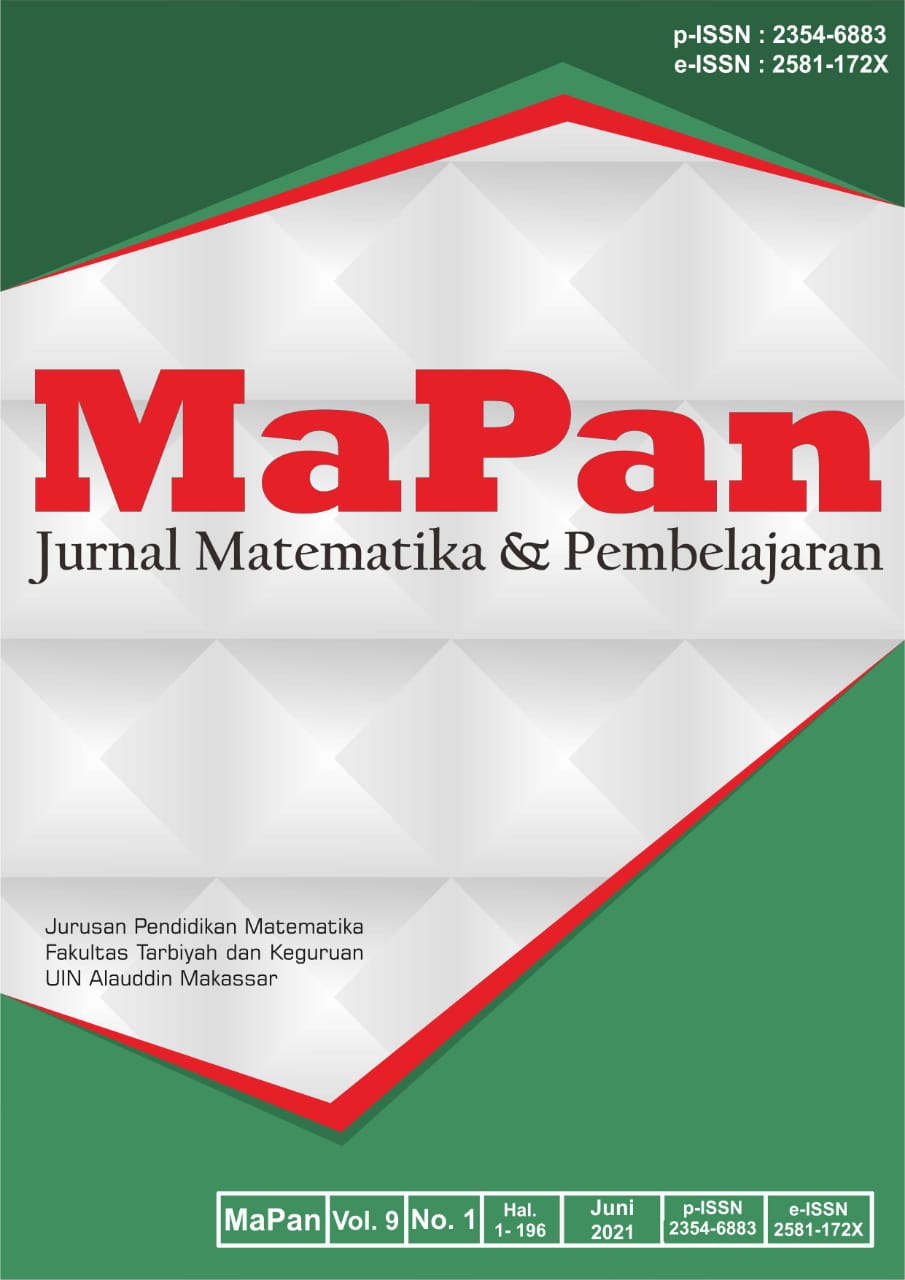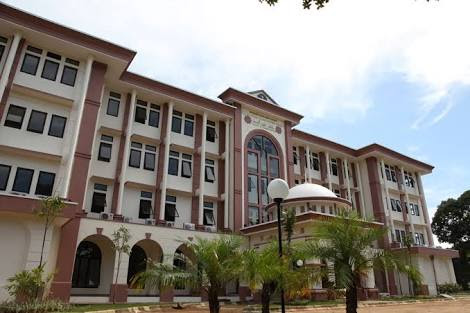THINKING STRUCTURE OF STUDENTS’ UNDERSTANDING OF PROBABILITY CONCEPT IN TERM OF APOS THEORY
Abstract
This study aims to analyze the mental structure experienced by students when understanding the concept of probability reviewed from APOS Theory and then suggests a lesson that accommodates the mental structure. APOS theory states that a learner forms a suitable mental structure when interpreting a mathematical concept. This study involved 106 third semester students who enrolled in Probability Theory. The students were given ACE (Activities, Classroom, Exercises) learning cycle treatment. After treatment, students were then given homework assignments that aim to reinforce the learning process. After the sixth week of learning, data were collected through a test. The results of this study are as follows: (1) the mental structure of students towards the concept of opportunity is still at the process level, not at the object-level, (2) Improving the learning of probability concept requires activities to improve verbal understanding, not only in the form of pictures and symbols. The alternative learning treatments are written in this article.Downloads
References
Ang, L. H. & Shahrill, M. (2014). Identifying students ’ specific misconceptions in learning probability. International Journal of Probability and Statistics, 3(2), 23–29. https://doi.org/10.5923/j.ijps.20140302.01.
Arnon, I., Cottrill, J., Dubinsky, E., Oktac, A., Fuentes, S. R., Trigueros, M., & Weller, K. (2013). APOS Theory : A framework for research and curriculum development in mathematics education. Springer.
Asiala, M., Brown, A., DeVries, D., Dubinsky, E., Mathews, D., & Thomas, K. (1996). A framework for research and curriculum development in undergraduate mathematics education. Research in Collegiate Mathematics Education, 2, 1–32. https://doi.org/10.1090/cbmath/006/01.
Asiala, M., Cottrill, J., Dubinsky, E., & Schwingendorf, K. E. (1997). The development of students’ graphical understanding of the derivative. The Journal of Mathematical Behavior, 16(4), 399–431. https://doi.org/10.1016/S0732-3123(97)90015-8.
Diaz, C. (2007). Assessing students’ difficulties with conditional probability and bayesian reasoning. International Electronic Journal of Mathematics Education, 2(3), 128–148. Retrieved from https://www.iejme.com/article/assessing-students-difficulties-with-conditional-probability-and-bayesian-reasoning.
Dreyfus, T. (2002). Advanced mathematical thinking processes. In D. O. Tall (Ed.), Advanced mathematical thinking (11th ed., pp. 25–41). Springer. https://doi.org/10.1007/0-306-47203-1_2.
Dubinsky, E. D., & McDonald, M. A. (2001). APOS : A constructivist theory of learning in undergraduate mathematics education research. in d. holton, M. Artigue, U. Kirchgraber, J. Hillel, M. Niss, & A. Schoenfeld (Eds.), The teaching and learning of mathematics at university level (Vol. 7, pp. 275–282). Kluwer Academic Publishers. https://doi.org/10.1007/0-306-47231-7_25.
Garcia-Martinez, I., & Parraguez, M. (2017). The basis step in the construction of the principle of mathematical induction based on APOS theory. Journal of Mathematical Behavior, 46(April), 128–143. https://doi.org/10.1016/j.jmathb.2017.04.001.
Garfield, J., & Ahlgren, A. (1988). Difficulties in learning basic concepts in probability and statistics : implication for research. Journal for Research in Mathematics Education, 19(1), 44–63. https://doi.org/10.2307/749110.
Ghahramani, S. 2005. Fundamental of prabobality and mathematical statistics. 2nd Ed. Boston (USA): PWS Kent.
Kilpatrick, J., Swafford, J., & Findell, B. (2001). Adding it up: helping children learn mathematics (N. R. C. mathematics learning study committee (ed.)). National Academies Press.
Lehman, H. (1977). On understanding mathematics. 27(2), 111–119.
Maharaj, A. (2010). An APOS analysis of students’ understanding of the concept of a limit of a function. Pythagoras, 0(71), 41–52. https://doi.org/10.4102/pythagoras.v0i71.6.
Mason, J., Burton, L., & Stacey, K. (2010). Thinking mathematically (2nd Edition). Pearson.
Meel, D. (2003). Models and theories of mathematical understanding : comparing pirie and kieren’s model of growth of mathematical understanding and APOS theory. CBMS Issue in Mathematics Education American Mathematical Society, 12.
Nur, F. (2013). Faktor-faktor penyebab berpikir pseudo dalam menyelesaikan soal-soal kekontinuan fungsi linear yang melibatkan nilai mutlak berdasarkan gaya kognitif mahasiswa. MaPan : Jurnal Matematika Dan Pembelajaran, 1(1), 69–91. Retrieved from http://journal.uin-alauddin.ac.id/index.php/Mapan/article/view/1127.
Recio, A. M., & Godino, J. D. (2001). Institutional and personal meanings of mathematical proof. Educational Studies in Mathematics, 48, 83–99. https://doi.org/10.1017/CBO9781107415324.004.
Salgado, H., & Trigueros, M. (2015). Teaching eigenvalues and eigenvectors using models and APOS Theory. Journal of Mathematical Behavior, 39, 100–120. https://doi.org/10.1016/j.jmathb.2015.06.005.
Syamsuri. (2016). Analysis of False-Semantic Proof Production in Undergraduate Mathematics Learning Based on APOS Theory. IOSR Journal of Research & Method in Education, 6(5), 44–49. https://doi.org/10.9790/7388-0605054449.
Syamsuri, Purwanto, Subanji, & Irawati, S. (2017). Using APOS theory framework : why did students unable to construct a formal proof ? International Journal on Emerging Mathematics Education, 1(2), 135–146. http://dx.doi.org/10.12928/ijeme.v1i2.5659.
Syamsuri, S., & Marethi, I. (2018). APOS analysis on cognitive process in mathematical proving activities. International Journal on Teaching and Learning Mathematics, 1(1), 1. https://doi.org/10.18860/ijtlm.v1i1.5613.
Tall, D. (2010). Perception, operations and proof in undergraduate mathematics. Community for Undergraduate Mathematics Sciences Newsletter University of Auckland, 21–28.
Tall, D. (2008). The transition to formal thinking in mathematics. Mathematics Education Research Journal, 20(2), 5–24. https://doi.org/10.1007/BF03217474.
Weber, K. (2003). A procedural route toward understanding the concept of proof. Proceedings of the 27th Conference of the International Group for the Psychology of Mathematics Education, 395–410.
Weller, K., Arnon, I., & Dubinsky, E. (2011). Preservice teachers’ understandings of the relation between a fraction or integer and its decimal expansion: Strength and stability of belief. Canadian Journal of Science, Mathematics and Technology Education, 11(2), 129–159. https://doi.org/10.1080/14926156.2011.570612.
Weller, K., Clark, J., & Dubinsky, E. (2003). Student performance and attitudes in courses based on APOS theory and the ACE teaching cycle. Research in Collegiate Mathematics Education, 12, 97–131. http://dx.doi.org/10.1090/cbmath/012/05.
Copyright (c) 2021 Syamsuri, Cecep AHF Santosa

This work is licensed under a Creative Commons Attribution 4.0 International License.


